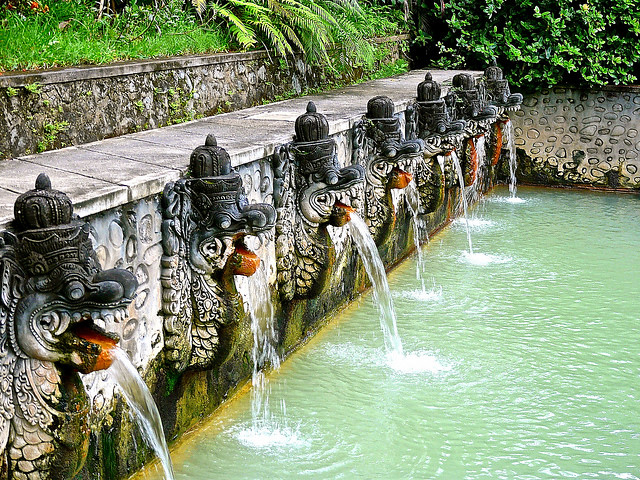Category Archives: Buddhism
An abecedary of Sacred springs of the world: Japan
Japan is a spiritual place. One of many sacred places. The majority of these being associated with the Shinto faith. Water is protected by the Suijin, a type of kami or Shinto spirit. These creatures were believed to be either serpents, eels or kappa . Women in the Shinto society were thought to be able commune with the Suijin and across Japan there are a number of sacred springs.
One important Shinto site is Mount Fuji which is doted with shrines or Akagami. In the grounds of the main one, Fujisan Hongu Sengen Taisha is a the sacred water of Mt Fuji said to have considerable healing properties. At the Goshado Shrine is the Sugatami-no Ido, or the Well of Full-Length Mirror, which is supposed to reflect the person’s remaining days who looks into the well. If no reflection is seen the person will die in three years!

Well of reflection I, KENPEI [GFDL (http://www.gnu.org/copyleft/fdl.html), CC-BY-SA-3.0 (http://creativecommons.org/licenses/by-sa/3.0/) or CC BY-SA 2.5-2.0-1.0 (http://creativecommons.org/licenses/by-sa/2.5-2.0-1.0)%5D, via Wikimedia Commons
A feature of the temples are the purification pools, or Mitarashi-no Ike, or ‘Holy Washing Pond’ Local legend states that at the one on Mount Hakusan that it is still haunted by mountain spirits and that it was formed in a single night, and through the years it has never run dry, even when the region was struck by droughts. At the Kashima Shrine, it is said that whether tall or short, the pond will have the same depth!
Japan’s other main religion is Buddhism and this too has it sacred water sources. The Daishi-do temple is set into the cliff of the Goishizan mountain. Dedicated to Shingon Buddhist founder Kobo Daishi. It is here that a spring can be found. Local legend tells us that Kobo Daishi formed it by hitting the ground with his staff. Beside the spring is a figure of Kannon, the Goddess of Mercy, a Buddhist Bodhisattva, an enlightened figure. What is interesting is that the area of Dounzan is especially sacred during the Summer Solstice because an image of Kannon appears on the rock said to caused by the light.
Of course Japan is particularly famed for its Onsen or Hot Springs, which are distributed widely across the country
An abecedary of Sacred springs of the world: The Balinese water temples of Indonesia
In the Hindu belief springs, wells and rivers are protected by nagas. They are thought to provide fertility, prosperity and provide in some cases immortality. Water worship in Indonesia is typified by their Pura Tirtra a water temple, and no where are these more well-known than that found near the town of Tampaksiring in Bali.
This site was founded during the Warmadewa dynasty around 962 A.D and it derives its name from the water source called Tirta Empul, a source of the Pakerisan river. Legendarily it is recorded that the spring arose as follows:
“The fight of gods and Beelzebub Mayadenawa continued. The Beelzebub threw the poison into the river one day. And, the gods died one after another drinking the water of the river. Indra who had survived only beat the earth with the cane, and, amrita ‘Amerta’ sprang up. And, gods revived, and defeated the Beelzebub.”
The temple itself is dedicated to the Hindu god, Vishnu and consists of a bathing area called a petirtaan where local devotees ritually purify themselves in the spring. The temple pond also has a spring which is considered amritha or holy. The temple has three sections: Jaba Pura (the front yard), Jaba Tengah (the central yard) and Jeroan (the inner yard). Jaba Tengah contains two pools with 30 showers which are named accordingly: Pengelukatan, Pebersihan and Sudamala dan Pancuran Cetik. These springs are said to be healing, purifying mind and body, particularly skin diseases.

Another famed holy spring, is the sulphur hot springs of Banjar. Here from the mouths of carved nagas flows the healing waters. The temple consists again of three pools. The top one, is a narrow pool which is shallow, having a consistent depth of metre, and the warmest. Below is another pool filled by five naga heads which is much larger and deeper by two metres. The third pool, the water flows from three spouts. This creates a focused spout of water which allow people to be massaged by the water. The pools are filled each morning and the pools gradually cool during the day, at the end of the day it is emptied to filled once more.



